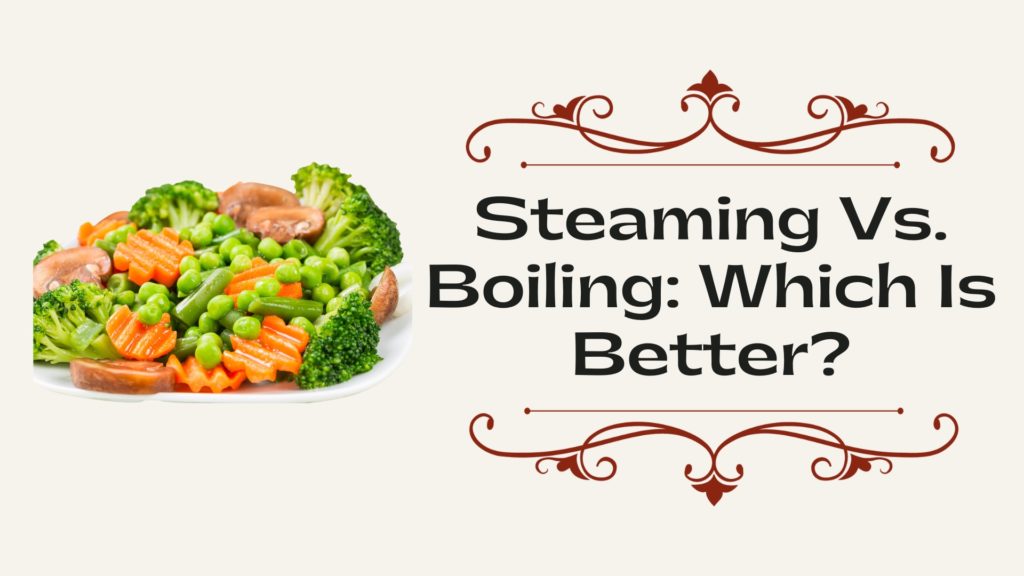
Steaming
If you enjoy eating a plate of crispy, tender, fresh vegetables with a unique taste, steaming is the way to go. You don’t have to worry about Trans fats since you add no fat when steaming. For that reason, calories should not be your concern since they will be minimal.
Unlike boiling, where most nutrients remain in the water when steaming, the nutrients remain intact. So you will enjoy taking minerals, enzymes, and vitamins in their original form. Do you have digestion problems? Relax. Steamed food has a tender texture that makes it easy for the body to absorb quickly.
Have you ever craved for food then lost appetite immediately you saw it? It’s probably because the food was mushy and colorless. You will never experience that with steamed food. Note that the food retains its lovely color, and it’s crispy. It’s not over-cooked, nor is it soaked in water.
It’s also cost-friendly and versatile. You can cook different types of dishes using this method. You can steam your meal and cook a variety of other recipes using the same heat source. Since no added fats, your food will have almost no smell. That eliminates the chances of unpleasant odor in some dishes caused by fat. That leaves your meal healthier, lighter, and tastier. What about the boiling method?
Boiling
Boiling is another healthy way of cooking your food. It makes your food safer by killing harmful microorganisms. For that reason, you will find that some people first boil their food, especially meat, before frying.
Cancer is among the most dreaded diseases in the world. Boiling food increases the release of antioxidants that aids in preventing premature aging of your body cells. If also protect the body from the spread of cancer cells.
Various foods contain oxalates. These compounds promote the formation of harmful kidney stones. To avoid taking chances, boil and remove up to 87% oxalates from your meals. Compared to frying, boiled food has higher nutritional retention that is helpful to your body and skin.
Many people suffer from stomach ulcers thanks to Helicobacter pylori. When you boil the food, it will be safer and will go easy on your stomach lining. The reason being, the food is softer, and the nutrients are in simpler forms.
Boiling is a versatile method; it takes less time to prepare with no much attention needed. Remember, the chances of your food getting charred are minimal, if any. Again, preparing food becomes easy. Unlike the frying method that takes your full attention, in boiling, you only add your ingredients to the pot cover and do other things.
Main Differences
With the two methods in mind, here is the difference between steaming and boiling your food.
Time
If you compare the two methods in terms of time, you will realize that steaming takes lesser time that boiling. When steaming, you can cook other dishes using the same heat source. That makes your cooking much faster and easier.
Nutrients
In the boiling method, water drains most of the nutrients from the food. If the food requires you to remove the water when eating, you will lose a lot of nutrients. Unless you are supposed to take the soup, this method is not suitable if you care about your nutritional intake. On the other hand, the steaming technique helps to retain the nutrients in your food. There could be a few of the nutrients that will be lost when steaming but can’t be compared with the massive loss when boiling.
Food Safety
The boiling method helps to kill all the harmful bacteria and other microorganisms. It’s an excellent method due to its food safety. Compared to steaming, boiling makes the food safer for consumption.
Color, Taste, and Texture
Boiling water makes your vegetables dull, soggy, and sloppy. That affects the color, texture, and taste of your veggies. Unlike the boiled food, steamed food does not come into contact with water. In return, it’s crisp and a bit crunchy and retains a bright color.
Unique Flavor
If you want your fish and veggies to retain their original flavor, you need to steam them. If you boil them, the water will interfere with it.
Between boiling and steaming, which is the best method? The type of food may determine the way to adopt. If you want to cook cons that are still in the cob, the best option would be to boil. But for dishes like vegetables and fish, you can use either another method. Both methods are suitable if you are checking on your calorie intake.
Here is the answer to your question. If you are concerned about the taste, texture, color, and flavor of your food, steams it. If food safety and sweet soup is your primary consideration, you should boil the food.
Conclusion

John DiBella is a graduate of The Culinary Institute of America, a cooking enthuthiast and a writer. When he’s not writing blogs about home kitchenware, he enjoys hiking, camping, sailing and cooking.
